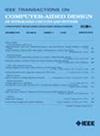一种基于最大故障采集和快速分析的HBM内置自修复方法
IF 2.9
3区 计算机科学
Q2 COMPUTER SCIENCE, HARDWARE & ARCHITECTURE
IEEE Transactions on Computer-Aided Design of Integrated Circuits and Systems
Pub Date : 2024-11-14
DOI:10.1109/TCAD.2024.3499903
引用次数: 0
摘要
高带宽存储器(HBM)代表了存储器技术的重大进步,它要求快速和准确的数据处理。内置自我修复(BISR)对于确保高容量和可靠的内存至关重要,因为它可以自动检测和修复内存系统中的故障,防止数据丢失并提高整体内存可靠性。提出的BISR旨在通过使用在离线和在线模式下都有效运行的内容可寻址存储器结构来提高修复率和可靠性。此外,一种新的冗余分析算法通过将故障信息转换为矩阵格式并关注每个修复方案的无故障区域,减少了分析时间和面积开销。实验结果表明,该方法提高了修复率,并在测试序列完成后立即得到最终修复方案。此外,硬件比较表明,随着内存大小的增加,所提出的方法减少了区域开销。因此,所提出的BISR提高了BISR的整体性能和HBM的可靠性。本文章由计算机程序翻译,如有差异,请以英文原文为准。
A Built-In Self-Repair With Maximum Fault Collection and Fast Analysis Method for HBM
High bandwidth memory (HBM) represents a significant advancement in memory technology, requiring quick and accurate data processing. Built-in self-repair (BISR) is crucial for ensuring high-capacity and reliable memories, as it automatically detects and repairs faults within memory systems, preventing data loss and enhancing overall memory reliability. The proposed BISR aims to enhance the repair rate and reliability by using a content-addressable memory structure that operates effectively in both offline and online modes. Furthermore, a new redundancy analysis algorithm reduces both analysis time and area overhead by converting fault information into a matrix format and focusing on fault-free areas for each repair solution. Experimental results demonstrate that the proposed BISR improves repair rates and derives a final repair solution immediately after the test sequences are completed. Moreover, hardware comparisons have shown that the proposed approach reduces the area overhead as memory size increases. Consequently, the proposed BISR enhances the overall performance of BISR and the reliability of HBM.
求助全文
通过发布文献求助,成功后即可免费获取论文全文。
去求助
来源期刊
CiteScore
5.60
自引率
13.80%
发文量
500
审稿时长
7 months
期刊介绍:
The purpose of this Transactions is to publish papers of interest to individuals in the area of computer-aided design of integrated circuits and systems composed of analog, digital, mixed-signal, optical, or microwave components. The aids include methods, models, algorithms, and man-machine interfaces for system-level, physical and logical design including: planning, synthesis, partitioning, modeling, simulation, layout, verification, testing, hardware-software co-design and documentation of integrated circuit and system designs of all complexities. Design tools and techniques for evaluating and designing integrated circuits and systems for metrics such as performance, power, reliability, testability, and security are a focus.

 求助内容:
求助内容: 应助结果提醒方式:
应助结果提醒方式:


